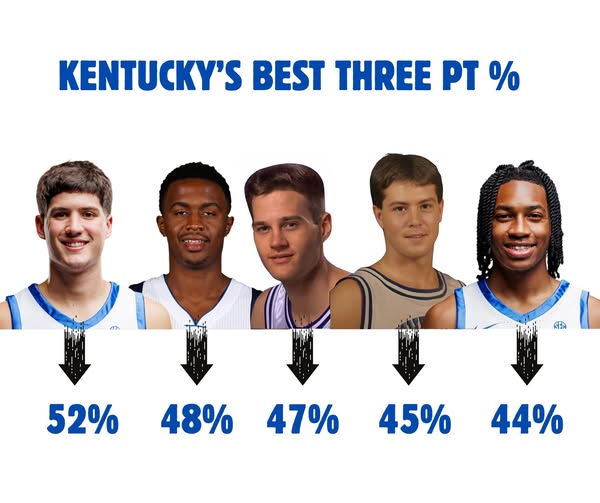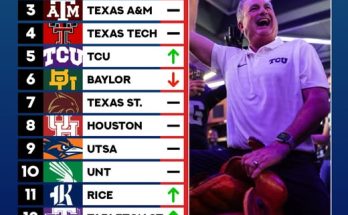Kentucky basketball has long been synonymous with excellence, producing some of the most talented and prolific shooters in college basketball history. The Wildcats’ legacy is steeped not only in legendary players who dominated inside the paint or dazzled with their athleticism but also in sharpshooters who have etched their names into the program’s record books through their deadly accuracy beyond the arc. When it comes to career three-point field goal percentage, Kentucky boasts a list of players who made the three-point shot a vital part of their game, combining consistency, precision, and clutch shooting to propel the Wildcats to countless victories. Among these elite marksmen, three names stand out prominently: Reed Sheppard, Doron Lamb, and Cameron Mills. Their remarkable careers highlight Kentucky’s tradition of fostering sharpshooters who impact the game on the perimeter.
Reed Sheppard’s name has recently come to the forefront as one of Kentucky’s most efficient three-point shooters of all time. With a staggering career three-point field goal percentage of 52.08%, Sheppard has established himself as one of the most reliable long-range shooters in the Wildcats’ history. To put this achievement into perspective, shooting over 50% from beyond the arc over an entire college career is an extraordinary feat, demonstrating not only precision but also a remarkable level of consistency against top-tier competition. Sheppard’s shooting ability is a combination of quick release, smooth mechanics, and basketball IQ, allowing him to find optimal spots and knock down shots even when tightly guarded. His role on the team, often as a key perimeter scorer, showcased his ability to stretch defenses and create opportunities for teammates. Fans and analysts alike have marveled at Sheppard’s composure under pressure, often delivering clutch three-pointers in crucial moments.
Before Sheppard’s rise, Kentucky’s three-point shooting prowess was epitomized by players like Doron Lamb, who carved out an impressive legacy with a career three-point percentage of 47.52%. Lamb’s shooting was a critical component of his game, complementing his scoring ability and defensive tenacity. During his time with the Wildcats, Lamb was known for his smooth stroke from deep and his confidence to take and make difficult shots. His three-point shooting was not merely about percentage but also about volume and impact. Lamb’s ability to score from long range helped Kentucky in many tight contests and high-stakes tournament games. His career serves as a benchmark for future Wildcats aspiring to excel as perimeter threats. Lamb’s contributions extended beyond just his shooting stats; he was a fierce competitor, and his three-point shooting was a weapon that teams had to respect, opening up driving lanes and facilitating offensive flow.
Cameron Mills is another name that deserves mention in Kentucky’s pantheon of three-point shooters. Although his exact career three-point percentage is not as widely cited as Sheppard’s or Lamb’s, Mills was a dependable shooter who made his mark through consistent perimeter scoring and timely three-pointers. Mills embodied the Kentucky spirit of hard work and adaptability, often taking on challenging defensive assignments while remaining a threat from long distance. His shooting mechanics and ability to get open shots contributed to his role as a valuable piece of the Wildcats’ offense. Like many Kentucky shooters, Mills understood the importance of spacing and shot selection, balancing his desire to contribute points with the necessity of efficient shooting. His three-point shooting helped spread defenses and provided Kentucky with an additional offensive weapon that kept opponents guessing.
Kentucky’s tradition of producing top-tier three-point shooters goes beyond just these three players. The Wildcats’ system under various coaches has emphasized the value of the three-point shot, evolving with the modern game’s increasing reliance on perimeter shooting. This has allowed players like Sheppard, Lamb, and Mills to thrive and leave lasting impressions on the program’s history. Their shooting percentages reflect not only their individual talents but also the environment that Kentucky fosters—one where players are encouraged to develop all facets of their game, including shooting from long range.
Examining the careers of these three players reveals how vital the three-point shot has become in Kentucky’s style of play. Reed Sheppard’s exceptional efficiency marks a new standard for Wildcats shooters, demonstrating how modern players combine skill, training, and basketball intelligence to maximize shooting percentages. His ability to shoot at such a high clip is a testament to hours of practice, mental focus, and physical conditioning. Sheppard’s shooting is not just a statistical marvel but also an aesthetic one, as fans delight in watching the ball effortlessly swish through the net time and time again.
Doron Lamb’s career, meanwhile, highlights the impact a great shooter can have on a team’s success in big moments. His volume shooting combined with high accuracy set the tone for Kentucky’s offense during his tenure. Lamb’s shooting prowess was a cornerstone of Kentucky’s attack and was instrumental in securing wins throughout his career. He represents a perfect balance of skill and competitive fire, inspiring the next generation of Wildcats to embrace the three-point shot as a weapon.
Cameron Mills’ contribution underscores the importance of reliable perimeter shooters who may not always grab headlines but whose steady shooting is crucial to team dynamics. Mills demonstrated that successful three-point shooting requires not only talent but also discipline, teamwork, and the ability to perform under pressure. His role within the Wildcats’ lineup helped the team maintain offensive versatility and adapt to different defensive schemes.
Together, these players exemplify Kentucky’s ability to develop and showcase some of the best long-range shooters in college basketball history. Their career three-point percentages—52.08% for Sheppard, 47.52% for Lamb, and a strong contribution from Mills—are indicative of their skill, dedication, and the Wildcats’ commitment to excellence. This tradition of shooting excellence continues to shape Kentucky basketball’s identity and ensures the program remains competitive in an era where three-point shooting is often the difference-maker.
Moreover, the success of these players in three-point shooting extends beyond just numbers; it influences the team’s offensive strategies, the spacing on the court, and how defenses approach Kentucky’s offense. When a team has sharpshooters like Sheppard, Lamb, and Mills, opponents must defend the perimeter aggressively, often stretching their defense thin. This creates opportunities for drives, post plays, and open shots for other teammates, demonstrating how critical three-point shooting is to the overall offensive ecosystem.
As Kentucky basketball moves forward, the legacy of players like Reed Sheppard, Doron Lamb, and Cameron Mills provides a blueprint for future Wildcats. Coaches and players alike recognize the value of a reliable three-point shooter and the competitive advantage it can yield in the fast-paced and ever-evolving game of college basketball. These players’ achievements set a high standard and inspire younger athletes to develop their shooting skills with precision and confidence.



